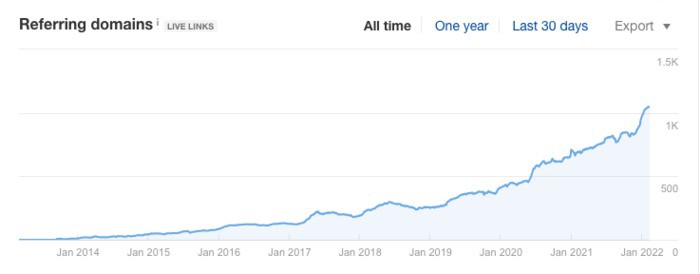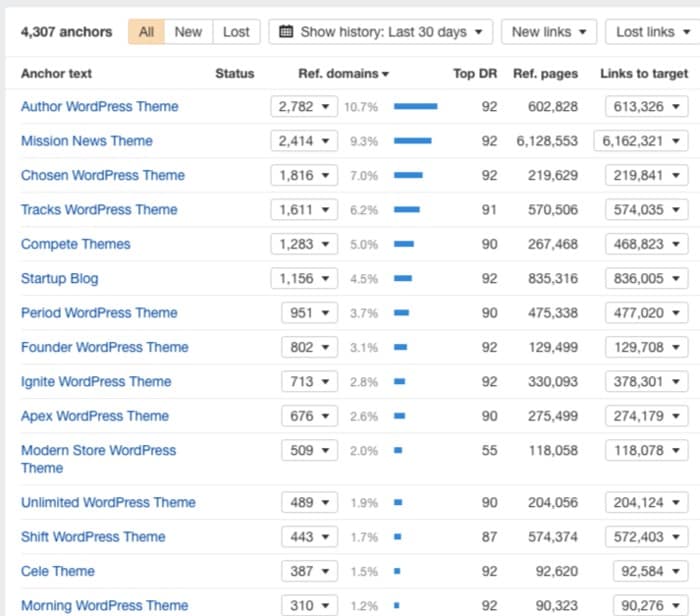by Venchito Tampon Jr | Last Updated on June 28, 2023
After conducting hundreds of backlink audit campaigns for our clients, we teach you the entire process to do it.
In this guide, you’ll discover:
- What is a backlink audit?
- Why backlink audit is important?
- 5 easy steps to do a backlink audit (in less than 30 minutes)
So finish this guide if you want to know if your website is in good shape through a simple backlink audit.
What is a backlink audit?
A backlink audit is the process of assessing all the links pointing to your website. It involves identifying both good and bad links and devising a strategy to address them. You can download your list of links from Google Webmaster Tools and manually review each backlink. It’s crucial for maintaining the health and credibility of your website.
In this activity, you want to ensure zero unnatural and toxic backlinks could harm your website, which could hinder future SEO initiatives or trigger a Google manual or algorithmic penalty.
Why do a backlink audit?
Performing a backlink audit is essential to ensure the health of your website. You can identify and remove any harmful or spammy backlinks by conducting a thorough analysis. This not only protects your site from potential penalties but also enhances your SEO efforts, allowing for better organic rankings and traffic.
Before you perform a backlink audit, you need to know why you should be doing it.
Here are three purposes of a backlink audit:
- Identify spammy inbound links to your website.
- Do more of what you did well in previous link building efforts.
- Get insights into your next link building plan.
Identify spammy inbound links.
You could’ve taken a new client, and you’re unaware that their previous agency built bad links to your client’s site.
Or your website has been hit by a negative SEO attack. Your competitors have done nasty things by building toxic links to your website instead of focusing on improving their backlink profile.
Either way, you want to know if you’ve got any spammy inbound links. You want to remove them as soon as possible as a course of action. Otherwise, you might receive a Google manual penalty, which could hurt your website’s organic traffic (and conversions)
Do more of what you did well in previous link building efforts.
A backlink audit isn’t just knowing the negative stuff. It also gives you the time to assess what works well and do more of them.
If you’ve been building and earning good backlinks, it is wise to replicate the types of links, link building strategies, and linkable content formats to improve your site’s backlink profile even more.
Get insights into your next link building plan.
Backlink audit helps you assess your website’s link profile against the competition.
With that, you can leverage a more cohesive action-oriented plan to outpace your competitor’s backlinks and outrank their performance in search results.
Insights gathered from backlink audits help you come up with a solid future link building plan.
Backlink Audit Tools
You need tools to help you gather valuable information about your backlinks.
In performing a backlink audit, you could use any of the following link building tools (or even combine them if you have spreadsheet skills):
- Moz
- Majestic
- Search Console
- Ahrefs
- Screaming Frog
- SEMRush
- Screaming Frog
- Link Assistant
My recommended tools for backlink audits are Ahrefs, Moz, and Majestic.
It is best to invest in at least one of the mentioned link intelligence tools, as you’ll not only be using them for backlink audit but for other essential link building tasks (e.g. competitor backlink research and link search).
In this guide, I’ll be using Ahrefs and Majestic. So let’s go about how to do a complete backlink audit in 30 minutes or less.
How To Do A Backlink Audit
Here is how to do a backlink audit in five steps:
- Get an overview of your backlink profile and of your competitors.
- Find low-quality backlinks to your website.
- Discover opportunities and methods by reviewing your backlink profile.
- Check for any broken backlinks you can fix.
- Strategize for your next link building plan.
Step 1: Get An Overview Of Your Backlink Profile and Of Your Competitors
In a backlink audit, you start from top to bottom.
This means you look from a high-level view of your backlink profile and then lean into details.
Begin by entering your domain into Ahrefs’ Site Explorer to see overview details of your backlinks.
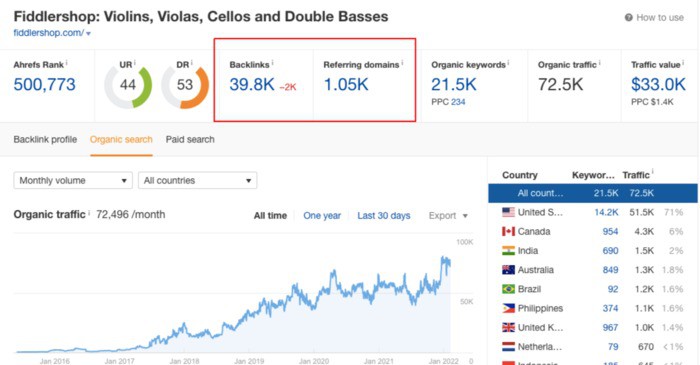
As of this writing, our example website has 39.8K total backlinks and 1.05K referring domains.
The number of backlinks and referring domains gives you a quantifiable metric for the current success of your link building campaign.
The higher your number with these numbers, the higher the domain rating you’ll get for your website. More backlinks from high authority sites increase your own site’s domain rating.
Sidenote: If you find an imbalance number between the two, say 1M backlinks while having only 5K+ referring domains, take a closer look at the website, as this might indicate that the site did shady link building strategies. More on this later.
Next thing to do:
Compute the average link gap between your website and your competitors.
You have to compute the average backlink gap to keep up with your competitors (or get ahead of them).
What is backlink gap?
Backlink gap is basically the estimated difference of links and referring domains between your competitors and your website.
It’s not an absolute number, though, but this gives you a rough estimate of how many links you should be pursuing to get ahead of the competition.
One tool you can use to compute for this initially is Ahrefs’ Domain Comparison feature.
When you enter your competitors’ domains, It shows you an overview of backlink data across multiple domains at a glance.
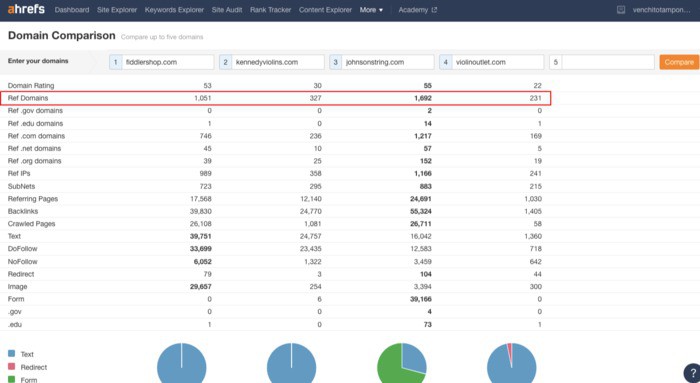
You can see directly here how many backlinks and referring domains your competitors have compared to yours.
The backlink gap isn’t just about the quantity difference.
So to calculate the backlink gap, you should focus on high-quality backlinks. The easiest way to get the links’ quality is by evaluating each referring domain’s DR. You can do it via Ahrefs’ Referring Domains report.
Once you have a list of websites and their DR, you need to export the results and see how many links are high-quality (DR > 70), medium quality (DR ≥ 30 ), and low-quality websites (DR < 30).
Sidenote: DR isn’t the only metric to assess link quality. Other tools offer similar metrics, such as Moz’ Domain Rating and Majestic Trustflow. But for the purposes of using Ahrefs, we use DR as our qualitative metric.
Another initiative to get a top-level view of the competition is to:
Assess your link velocity rate in comparison to your competitors.
The link velocity rate is the speed at which backlinks to your website are added over a specific period of time.
You can be so fast at a given time, which might dictate a potential negative SEO attack, or so slow that your competitors are outcompeting you regarding links.
To check link velocity, you can see the website’s referring domains graph on Ahrefs’ Site Explorer overview.
Sidenote: Check if there is a big burst or big drop on referring domains graph. A big burst might indicate a potential negative SEO attack, while a big drop might signal loss of links to specific pages.
Speaking of potential harm to your website, your next activity should be to:
Look for potential spam and keyword-rich anchor text in your profile.
Harmful links are easy to detect by looking at how they link to you — anchor text.
One is checking for any dodgy anchor texts and keyword-rich anchor texts.
Ahrefs provides an anchor text section of all backlinks in your profile.
A good anchor text profile must compose of branded anchor texts, as this is a natural way for other publishers to link to their external sources.
Check if there are any dodgy anchor texts:
Or high-density keyword-rich anchor texts:
Sidenote: Backlinks with keyword-rich anchor texts aren’t necessarily bad. In fact, it’s common to have this type of anchor text. However, if you see that the high density of your anchor texts (let’s say 70 to 90%) are all keyword-rich anchor texts, consider it for a backlink audit execution.
Covered this earlier, but it’s good to separate this one:
Check for possible negative SEO attacks.
Are there any big spikes or big dips in referring domains graph?
Big spikes might indicate negative SEO to your website. Other webmasters and SEOs may be trying to pull your site’s organic traffic by building toxic backlinks to your pages.
What will you do then?
Ignore or disavow.
Why and how?
Read our next step. I’ll get into this in a little more detail.
Step 2: Find Low-Quality Backlinks To Your Website.
This is one of the important steps in a backlink audit.
The reason you want to find low quality backlinks is to remove them (at all costs if you can).
Toxic, irrelevant backlinks could hinder your SEO growth in the future if not taken into consideration.
So how do you find low-quality backlinks?
First, know the difference between good backlinks and bad backlinks.
You can’t find them if you don’t know their nature and if they are considered as bad.
Good Backlinks VS Bad Backlinks
What is a good backlink?
A good backlink is editorially given.
Editorially given links are natural backlinks. These are links gained without any manipulation or even some kind of manual outreach.
You create value from the content or any other web assets, and that’s why they link to you.
A good backlink is from a reliable website.
A reliable website is a website that has an intended audience. It speaks to a target market (e.g. tech-savvy people).
You’ll know if a website is good when the website has a real audience (readers). If it’s a blog, you can check the website’s social engagement and its comment section. There you’ll know that it has a community of readers.
A reliable website has good-quality content. The information isn’t generated by any AI copywriting tools or spun content by getting original content and running it through a word spinner content to make it look original.
You know that the content is high-quality when you can read information from beginning to end and still understand it.
A good backlink is from an authoritative website.
Authority is relative. But it can easily be determined by a quantifiable metric such as Ahrefs’ Domain Rating.
An authoritative website must have a Domain Rating (or Moz’ Domain Authority) of 25 and above.
Sidenote: Some domains may have low DR given that they don’t have many links yet pointing to the website. However, these low-DR websites have real authors and readers and are good sources of backlinks.
A good backlink is do-follow.
Dofollow backlinks improve link equity to destination pages, which is great for ranking websites.
While you can naturally get no-follow backlinks, you must aim for do follow backlinks, as it passes more link juice to your website.
Sidenote: Do not discount no-follow backlinks, as it makes your backlink profile natural. But if you want to maximize your outreach efforts, pursue link opportunities that are do-follow because they pass link juice to your website.
Now, it’s time to know what a bad backlink is.
It’s the opposite characteristics of a good backlink.
What is a bad backlink?
A bad backlink is from a spammy source.
They don’t come from reliable websites.
Bad backlinks are from websites of low-quality Private Blog Network, content farms, and generic low-quality directories.
Bad backlink is from a website with rich exact match anchor texts.
A high density of keyword-rich anchor texts can harm your website. Unnatural anchor texts signal your website to be manipulating each and every manual outreach effort.
Bad backlink is from elicits websites.
Elicit websites are porn, gambling, hate, adult, and unsafe.
Bad backlink is related to spammy content.
Spammy content doesn’t offer much value to its readers. Whether it is spun or AI-generated or it has grammatical errors. In other words, hard to consume for a general audience.
Bad backlink is a no-follow link.
No-follow backlinks don’t pass any link juice to your website.
Now, you know exactly the difference between a good backlink and a bad backlink.
Let’s get right to how you can find spammy backlinks.
How to Find Low Quality Backlinks?
1. Enter your domain in Majestic to get backlink data.
(I use Majestic this time as it gives me a more accurate spam score for backlinks through its Trust Flow).
Export all backlinks.
2. Sort links according to spam metrics.
Different link intelligence tools have different spam metrics.
Moz has its Spam Score. Majestic has its Trustflow. For Ahrefs, you can use its Organic Traffic.
Get low-quality links from the list that have either:
- Moz’ Spam Score (Spam Score <8)
- Majestic’s Trustflow (TF <15)
- Ahrefs’ Organic Traffic (<500)
Sidenote: You may be tempted not to check high-DR (DA) websites as it seems they don’t have any indication for spam. But it is best to review high DR websites but with low organic traffic.
Review websites with insignificant backlinks to referring domains ratio (e.g. 500K backlinks > 1K referring domains).
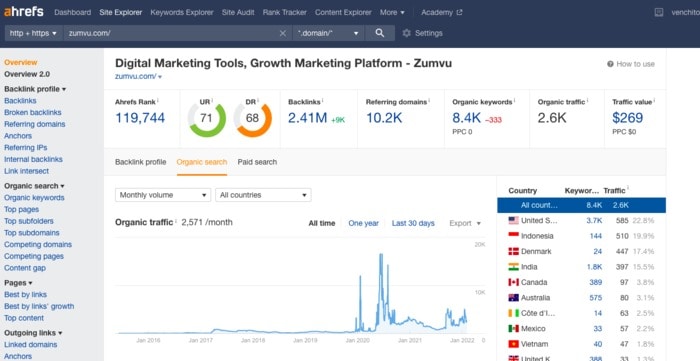
Next:
3. Check anchor texts of these low-quality links.
Dig deeper.
See if they have irrelevant anchor texts or keyword-rich anchor texts.
Make a note of these links with spammy anchor texts.
4. See their link types.
Bad backlinks are from non-authoritative websites and low-quality content (as mentioned earlier).
Check if any low-quality links are content farms, UGC (user-generated content), forums, and comments.
Also, make a note of these.
5. Manually check suspicious-looking websites.
Dig deeper and deeper.
After reviewing links with spammy anchor texts and low-quality link sources, check other websites with low spam scores.
There are other bad or spammy indications to links that are more obvious when you see the website.
Is the website full of display ads that the actual content gets difficult to read?
Does the website have a general (non-niche) audience?
Does the website have an old-school (the early 2000s) design template?
These are just a few things to look at in the backlink source to assess their link quality.
Now you need to:
6. Have a final list of websites.
This should be a list of backlinks:
- From low-quality link sources
- With irrelevant or keyword-rich anchor texts
- PBN-looking websites (old-school design template)
- From spammy content
- From irrelevant and/or elicits websites
Once you have a list, you have three courses of action:
Ignore these toxic links.
Because Google’s algorithm has become so advanced in checking spammy links, they simply ignore backlinks to a website.
Especially if your website has gained authority and trust as it builds natural, high-quality links and offers readable and high-quality content.
Google will simply ignore your toxic links.
But if this is not your preferred action, you may:
Request for backlink removal.
Find all email addresses of websites hosting these spammy links.
Contact those webmasters and ask them to remove your backlink.
There are cases where they would ask you for a payment before removing your link. For me, this is not worth your money (you should’ve invested it in link building).
If, in any case, some won’t remove your backlinks, it’s time to disavow them.
Disavow
Disavow is simply telling Google that you don’t count certain backlinks of your website.
To start with this, list down all domains or web pages you find to be low-quality.
Then go to Search Console and to its disavow tool.
You can check out the following guides to give more details on how to disavow toxic links:
Step 3: Discover Opportunities and Methods By Reviewing Your Backlink Profile
Backlink audit is not only about finding low quality backlinks to your website.
It is also discovering the best opportunities and methods.
Start by reviewing your backlink profile.
If your website has been successful in increasing its organic traffic. Plus, it attracts new backlinks every month.
It is best to uncover some content ideas.
How?
Use “Best by links” feature.
See which pages on your site have gained the most referring domains.
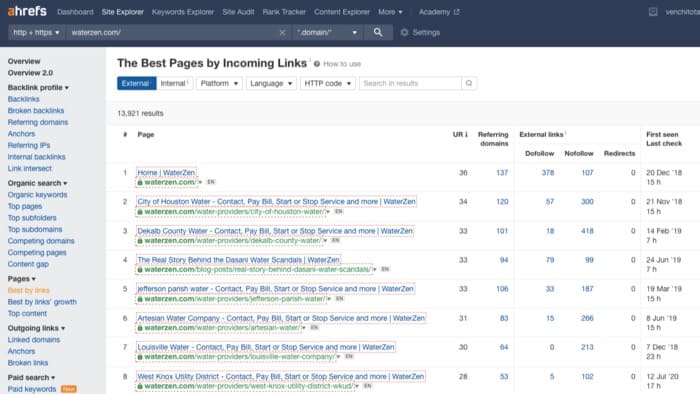
You can assess which content formats, length of content, and topics have resonated most with your linkable audiences.
From this insight, you can create similar types of content to continue the momentum of gaining new inbound backlinks to your site.
Another important discovery:
Use “Best by links growth” feature of Ahrefs to know what pages naturally attract backlinks.
The first one knows the type and topic of content that works, with or without manual outreach, to get links.
This time, it’s more of getting insights into what gives your site the ability to attract backlinks, even without doing email outreach.
By link growth, you see that the page attracts new links from publishers who used it as references for their content (they see it ranking on the first page while looking for references in search).
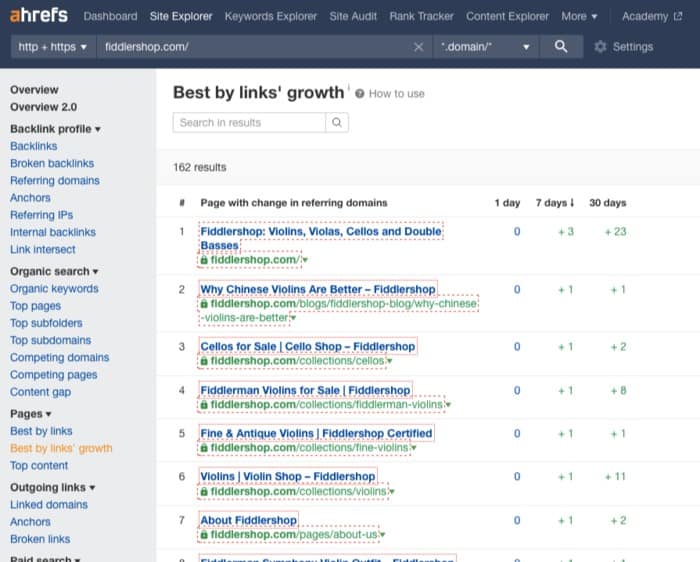
This is an important process, as you can also use it for your competitors to see what pages bring them the most backlinks.
Besides links, you also want to know this:
Know what websites bring you the most traffic.
Go to Ahrefs and view Backlinks report.
Sort websites based on Traffic.
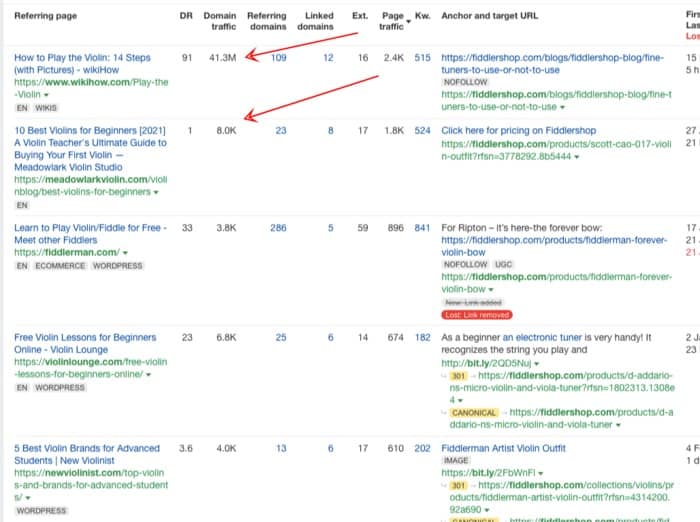
You want to know what websites pointing to your site bring the most referral traffic.
This insight leads you to improve your link building strategies.
One is to go after these publications and contribute more guest posts to increase the traffic you get from them.
Another way is to build content assets that resonate with high-traffic websites. So when you reach out to them and promote your content, you know it’s something they’d be interested in linking as external sources.
Want some more actionable methods?
Read the next link building opportunity.
Discover patterns between your inbound links.
If you can identify commonalities between your most powerful backlinks, you start to understand why these people are linking to you.
Finding new backlink prospects that can help move the needle for your rankings becomes easier.
In summary, to get insights and methods by reviewing your backlink profile:
- Use “Best by links” feature to uncover content ideas.
- Use “Best by links growth” to know what pages naturally attract backlinks.
- Know what websites bring you the most traffic.
- Discover patterns between your inbound links.
Step 4: Check For Any Wasted Backlinks You Can Fix
Wasted backlinks are links that have brought value, but not giving desired link juice to your site anymore.
So what do you do about them?
Check for any wasted links and try to fix them.
How?
First:
Find broken pages of your websites with inbound links.
This is an overlooked opportunity in link building:
Pages that gained backlinks but given they are no longer function, these links are put to waste.
So, start identifying these broken pages by using “Best by links” feature of Ahrefs.
Then search for 404 pages by simply clicking the drop menu.
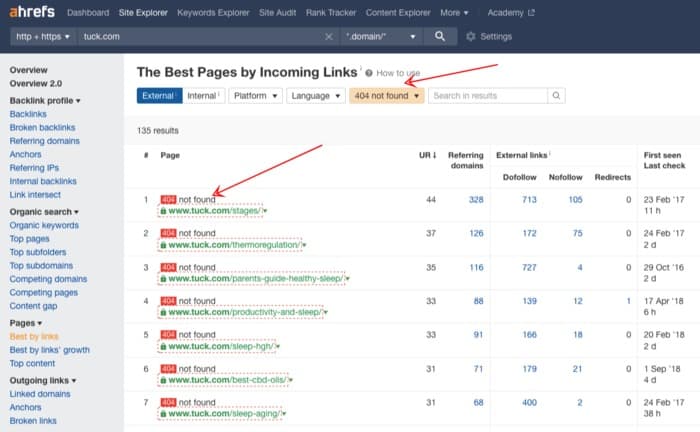
These are defunct pages with links.
Your action could be:
Redirect these broken pages to similar content on your site. This will pass link juice to your new page and, thus, help your linked-to page to rank for its target keyword.
Another plan is to create an entirely new page that covers the topic.
Once you publish your new page, you can reach out to publishers and webmasters linked to your broken page. Ask them to change their external links (from the old broken page to a new page).
Find pages with inbound links but with little to no organic search traffic.
You also want to look at pages needing internal linking to push their rankings up in search results.
How to find them first?
Once you enter the domain in Ahrefs Site Explorer, go to “Top Pages” report from Organic Search tab.
Filter pages based on Traffic maximum of 50 to only get pages that receive 0 to 50 in organic traffic.
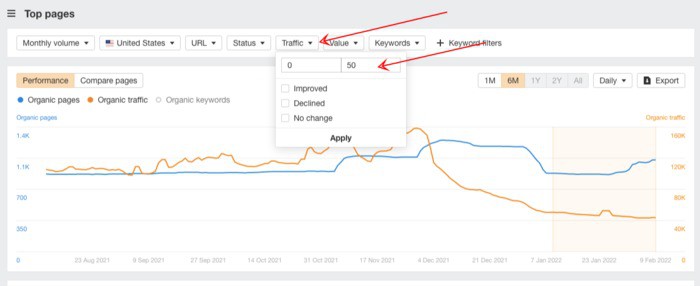
Export the results and examine them further.
Enter URLs in the Batch feature of Ahrefs so you can see how many referring domains are pointing to each page.
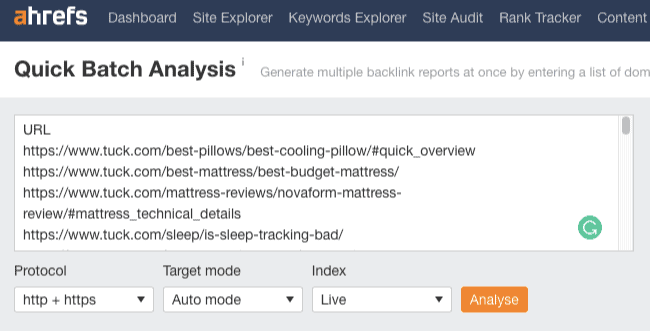
Sort the list from highest to lowest referring domains to arrive at pages with little to no organic traffic but receives a good number of referring domains.

What will you do with them?
Update and optimize this content.
Make sure on-page and off page SEO elements are added to the page. This doesn’t only help the content to improve its rankings but also acquire additional inbound links.
Last thing for backlink audit:
Step 5: Strategize For Your Next Link Building Plan
After weeding out toxic links and seeing methods and more link opportunities to your website, your next action is to have a better link building plan.
This goes to say you’ll think not just about the details of your website but from a view of your competitors.
Here are some tips in this last phase to make it work for your link building campaign:
Assess the right balance of distribution of efforts to your pages.
Not all pages deserve your attention if you’re doing manual outreach for links.
There are only linkable assets that you can promote and could give you links from interested linkers.
Make a list of these linkable information pages.
Then, add to your list are landing pages you aim to rank for. These pages are part of your mid to bottom-of-the-funnel strategy that brings sales to your brand.
Now, you have linkable informational pages and landing pages in your list.
Here are some considerations when you decide which pages to build more links to:
What commercial pages are sitting in positions 6 to 20 in search results?
More backlinks to these pages can help improve their rankings and drive more revenue to your business. There is a huge difference in clicks from a page ranking at #1 from its competing page ranking at #6.
You can use Ahrefs to find these pages quickly.
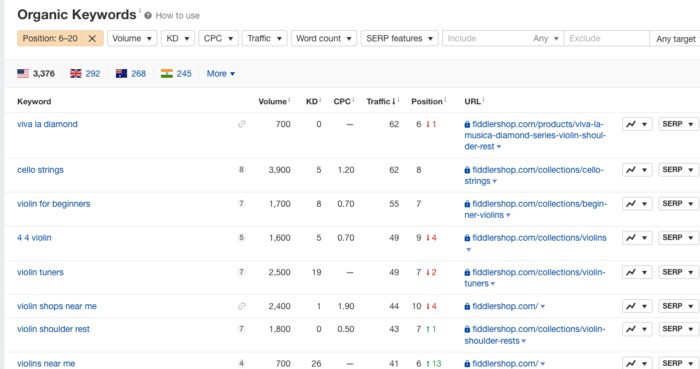
Or you can go straight to “Top Landing Pages” report.
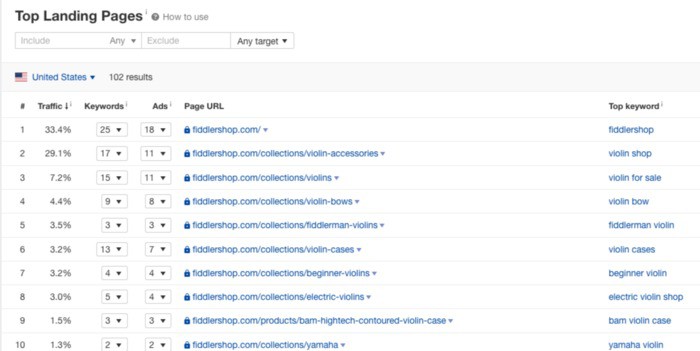
What pages are bringing you traffic but receive zero to few backlinks?
These are the pages that bring money to your website.
Building more links to these pages can drive up their rankings and increase your site’s overall traffic value.
How to find them?
Enter your domain and go to “Top Pages” report.
Export the list. Then filter to less than 10 RD (Referring Domains).
Then sort the list by ascending Traffic.
Here, you’ll see a list of pages with the most traffic value, but with less than 10 referring domains.
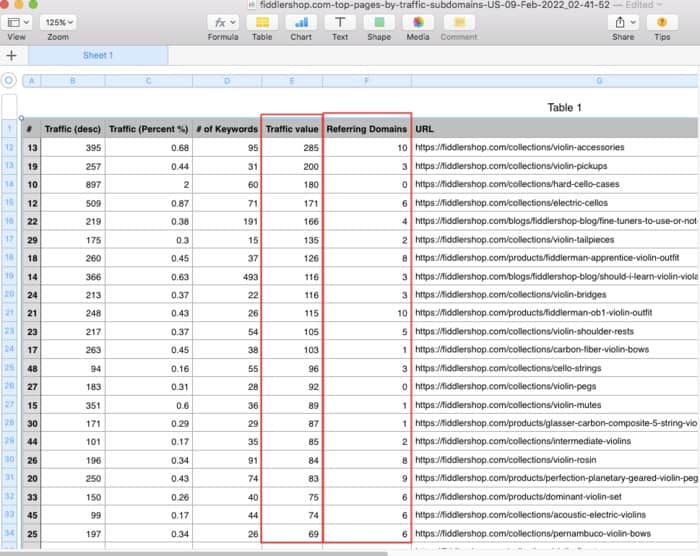
You can use our two considerations above to make a decision on which pages to push more links to.
Select pages for targeted links based on the backlink gap index. [ADVANCED]
Your next link building plan includes how to outperform your competitors.
That includes the quality and quality of backlinks you’re building against them.
We’ve covered how to compute the backlink gap in the middle section of this guide. It is basically the difference between your site’s number of referring root domains and your competitors’ websites.
You can compute the backlink gap index if you want a more accurate number.
So on top of linking the root domain gap, you also compute the volume/gap ratio.
To compute this, simply divide the link gap into the search volume. See the example computation below from Garett French’s guest ost on Moz.
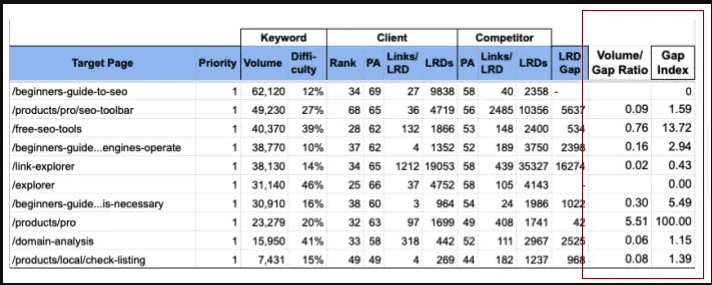
Know these two numbers: value per link VS cost per link.
Have a rough estimate of how much you spend to earn a single link.
While there are different variables to cost per link, finding a good number gives you an idea if you’re spending too much.
For this section, here are good resources that exactly shows how to compute for value per link and cost per link:
Assess and Improve Your Link Building Campaign
A backlink audit aims to assess the current status of your backlink profile while identifying toxic backlinks you can remove and discovering opportunities you can maximize.
Keep this in mind. Every website is different. Some backlink audits might take days to finish; if done well, others can initially be done in 30 minutes.
Backlink Audit Frequently Asked Questions
What is backlink audit pro?
Backlink audit pro refers to thoroughly assessing all the inbound links to your website and determining their value and quality. By creating a comprehensive list of linking sites, you can evaluate each link and classify it as either beneficial or detrimental to your site’s ranking and reputation. Ultimately, this analysis helps you optimize your backlink profile and improve your website’s performance in search engine results.
How do I verify backlinks?
To verify backlinks, obtain a comprehensive analysis of the target’s backlink profile. This will provide a breakdown of the websites referring to the target, helping you assess the quality and relevance of the backlinks. Analyzing backlinks is essential for understanding the link profile’s strengths and weaknesses to improve your SEO strategies.
How do I remove harmful backlinks?
There are a few steps you can take to remove harmful backlinks:
- Reach out to the website owner: If you can identify the website owner or webmaster, you can try reaching out to them and asking them to remove the backlink.
- Use the “disavow” tool in Google Search Console: If you cannot remove the backlink through other means, you can use the “disavow” tool in Google Search Console to tell Google not to consider the backlink when evaluating your website. To use the disavow tool, you must create a list of the URLs of the backlinks you want to disavow and submit the list to Google.
- Monitor your backlink profile: It is important to continue monitoring your backlink profile to ensure that new harmful backlinks are not added. You can use a backlink analysis tool to track your backlinks and identify any new low-quality or spammy links that may have been added.
- Implement a backlink removal strategy: If you cannot remove harmful backlinks through the above methods, you may need to implement a more comprehensive backlink removal strategy. This could include using the disavow tool, reaching out to website owners, and using other tactics to decrease the value of harmful backlinks.
It is important to note that removing harmful backlinks can be a time-consuming process, and it may take some time to see the results of your efforts. However, improving the quality of your backlink profile can have long-term benefits for your website’s search engine rankings.
How often should I perform a backlink audit?
It is generally recommended to perform a backlink audit regularly, as the quality and relevance of your backlinks can change over time. Some experts recommend performing a backlink audit at least once a year, although more frequent audits may be necessary for websites with a large number of backlinks or those that are facing significant ranking fluctuations.
Here are a few other factors to consider when deciding how often to perform a backlink audit:
- The size and complexity of your website: If your website has many pages and a complex backlink profile, you may want to perform a backlink audit more frequently to ensure that all of your backlinks are being properly evaluated.
- The competitiveness of your industry: If you are in a highly competitive industry, you may want to perform a backlink audit more frequently to ensure that your website is not outranked by competitors with stronger backlink profiles.
- Your overall marketing strategy: If you are actively improving your search engine rankings, you may want to perform a backlink audit more frequently to identify opportunities to build high-quality backlinks.
Ultimately, the frequency of your backlink audits will depend on your website’s specific needs and goals. It is important to find a balance between conducting frequent audits to ensure the quality of your backlink profile while also not spending too much time on this task.
The Author
Venchito Tampon Jr
Venchito Tampon is a Filipino Motivational Speaker, Corporate Trainer, and a Leadership Speaker in the Philippines. He is the CEO and Co-Founder of SharpRocket, a link building agency. With a decade of experience, Venchito has a proven track record of leading hundreds of successful SEO (link builidng) campaigns across competitive industries like finance, B2B, legal, and SaaS. His expert advice as a link building expert has been featured in renowned publications such as Semrush, Ahrefs, Huffington Post and Forbes. He is also an international SEO spoken and has delivered talks in SEO Zraz, Asia Pacific Affiliate Summit in Singapore, and Search Marketing Summit in Sydney, Australia. Check out his other businesses, Hills & Valleys Cafe, Blend N Sips and Saas Pursuit.
How our LINK BUILDING AGENCY builds 250 links/mo consistently using Predictable Link Building Methodology™…
- Using a SIMPLE and PROVEN system
- Using a SCALABLE strategy
- No private blog networks
- No creepy outreach emails
